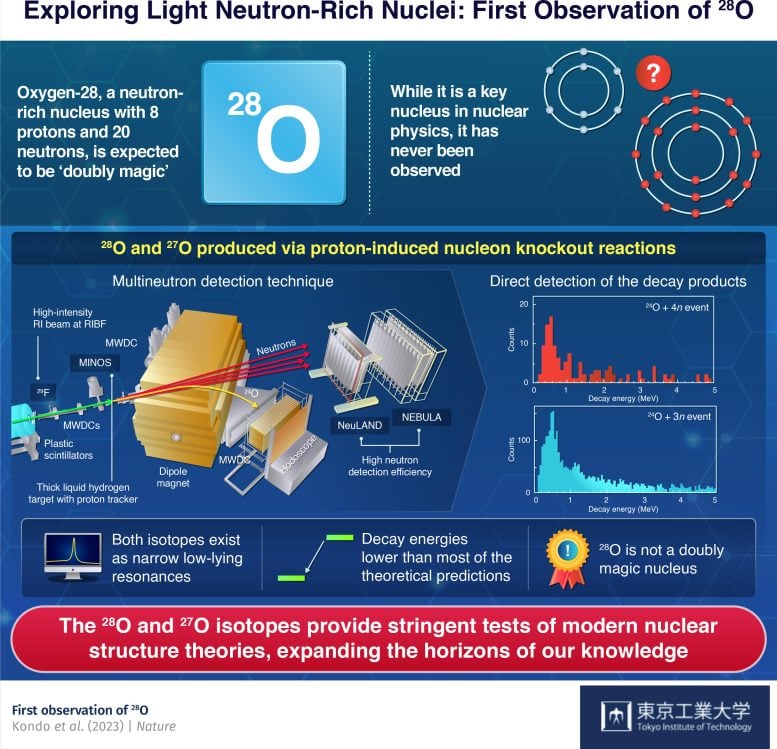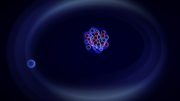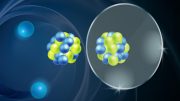
Researchers observed the decay of neutron-rich isotopes 28O and 27O into oxygen-24, providing new insights into nuclear structure theories and suggesting the ‘island of inversion’ extends into oxygen isotopes, enabling detailed studies of multi-neutron correlations and exotic systems.
The study of physical systems under extreme conditions offers valuable insights into their organization and structure. In the realm of nuclear physics, neutron-rich isotopes, particularly the lighter ones with a neutron-to-proton ratio notably different from stable nuclei, provide stringent tests of modern nuclear structure theories. These isotopes exist as very short-lived resonances, decaying through spontaneous neutron emission.
Now, in a new study published in available in Nature, an international collaboration of researchers led by Yosuke Kondo, an Assistant Professor at the Department of Physics at Tokyo Institute of Technology, reports the first observation of two such isotopes—oxygen-28 (28O) and oxygen-27 (27O)—through their decay into oxygen-24 with four and three neutrons, respectively. The nucleus 28O, which consists of 8 protons and 20 neutrons (N), is of significant interest as it is expected to be one of the few ‘doubly magic’ nuclei in the standard shell-model picture of nuclear structure.
The study’s success was enabled by the capabilities of the RIKEN RI Beam Factory, which could produce intense beams of unstable nuclei coupled to an active target of thick liquid hydrogen and multi-neutron detection arrays. Proton-induced nucleon knockout reactions from a high-energy 29F beam generated the neutron-unbound isotopes 27O and 28O. The researchers observed these isotopes and studied their properties by directly detecting their decay products.

The 28O and 27O isotopes provide stringent tests of modern nuclear structure theories, expanding the horizons of our knowledge. Credit: Tokyo Tech
They found that both 27O and 28O exist as narrow low-lying resonances and compared their decay energies to the results of sophisticated theoretical models—a large-scale shell model calculation and a newly developed statistical approach—based on effective field theories of quantum chromodynamics. Most theoretical approaches predicted higher energies for both isotopes. “Specifically, the statistical coupled-cluster calculations suggested that the energies of 27O and 28O can provide valuable constraints for the interactions considered in such ab initio approaches,” points out Dr. Kondo.
“The researchers also investigated the cross-section for the production of 28O from the 29F beam, finding it to be consistent with 28O not exhibiting a closed N = 20 shell structure. “This result suggests that the ‘island of inversion,’ whereby the energy gap between neutron orbitals weakens or vanishes, extends beyond the fluorine isotopes 28F and 29F into the oxygen isotopes,” explains Dr. Kondo.
The present findings enhance our understanding of nuclear structure by offering new insights, especially for extremely neutron-rich nuclei. In addition, the detailed investigation of multi-neutron correlations and the study of other exotic systems now become possible with the multi-neutron-decay spectroscopy technique utilized here.
Let us hope that future research unravels many more mysteries surrounding nuclei!
Reference: “First observation of 28O” by Y. Kondo, N. L. Achouri, H. Al Falou, L. Atar, T. Aumann, H. Baba, K. Boretzky, C. Caesar, D. Calvet, H. Chae, N. Chiga, A. Corsi, F. Delaunay, A. Delbart, Q. Deshayes, Zs. Dombrádi, C. A. Douma, A. Ekström, Z. Elekes, C. Forssén, I. Gašparić, J.-M. Gheller, J. Gibelin, A. Gillibert, G. Hagen, M. N. Harakeh, A. Hirayama, C. R. Hoffman, M. Holl, A. Horvat, Á. Horváth, J. W. Hwang, T. Isobe, W. G. Jiang, J. Kahlbow, N. Kalantar-Nayestanaki, S. Kawase, S. Kim, K. Kisamori, T. Kobayashi, D. Körper, S. Koyama, I. Kuti, V. Lapoux, S. Lindberg, F. M. Marqués, S. Masuoka, J. Mayer, K. Miki, T. Murakami, M. Najafi, T. Nakamura, K. Nakano, N. Nakatsuka, T. Nilsson, A. Obertelli, K. Ogata, F. de Oliveira Santos, N. A. Orr, H. Otsu, T. Otsuka, T. Ozaki, V. Panin, T. Papenbrock, S. Paschalis, A. Revel, D. Rossi, A. T. Saito, T. Y. Saito, M. Sasano, H. Sato, Y. Satou, H. Scheit, F. Schindler, P. Schrock, M. Shikata, N. Shimizu, Y. Shimizu, H. Simon, D. Sohler, O. Sorlin, L. Stuhl, Z. H. Sun, S. Takeuchi, M. Tanaka, M. Thoennessen, H. Törnqvist, Y. Togano, T. Tomai, J. Tscheuschner, J. Tsubota, N. Tsunoda, T. Uesaka, Y. Utsuno, I. Vernon, H. Wang, Z. Yang, M. Yasuda, K. Yoneda and S. Yoshida, 30 August 2023, Nature.
DOI: 10.1038/s41586-023-06352-6
The study was funded by the Japan Society for the Promotion of Science, Deutsche Forschungsgemeinschaft, GSI-TU Darmstadt cooperation agreement, GSI, German Federal Ministry for Education and Research, European Research Council, H2020 European Research Council, Swedish Research Council, Franco-Japanese LIA-International Associated Laboratory for Nuclear Structure Problems, French ANR-14-CE33-0022-02 EXPAND, Institute for Basic Science in Korea, U.S. Department of Energy, National Science Foundation, National Supercomputer Centre, HIC for FAIR and Croatian Science Foundation, National Research, Development and Innovation Fund of Hungary, Innovative and Novel Computational Impact on Theory and Experiment (INCITE) program, and the Swedish National Infrastructure for Computing.









In the realm of nuclear physics, neutron-rich isotopes, particularly the lighter ones with a neutron-to-proton ratio notably different from stable nuclei, provide stringent tests of modern nuclear structure theories. However, in scientific research, falsifiability is more important than confirmation.
If you are really interested in science, you can browse https://zhuanlan.zhihu.com/p/643404671.